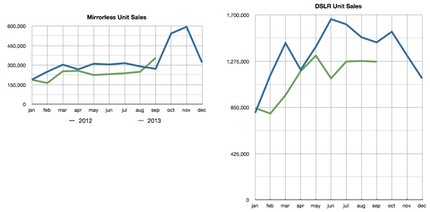(news & commentary)
Nikon posted results for the first half of their fiscal year today, and the news is mixed.
Unit sales compared to last year were down:
- DSLRs and Nikon 1: 87%
- Lenses: 88%
- Compacts: 70%
On the other hand, compared to Nikon's forecasts, the unit volume was about where they expected. But actual dollars taken in by those expected sales were lower than forecast, meaning that average selling price is slipping for Nikon faster than they thought. Yet, as I noted, mixed results: they managed to drive costs down enough to actually beat profit forecasts by 8%. One suspects that there were a lot of spreadsheet creation and number crunching going on this past quarter trying to micromanage all the competing factors that had to be juggled.
For the full year, Nikon is forecasting about even overall sales for year-to-year (that means they've revised their forecast of sales downward) but they expect to make an improved profit year-to-year, an extraordinary feat in the market environments they compete in.
Precision Equipment (semiconductor manufacturing equipment) is responsible for a bit of this, with Nikon showing more confidence that this business is recovering in their forward estimates. They now forecast 20% growth in that division in terms of sales, with their operating income increasing from 7.3% to 8.8% of sales.
In Imaging, the forecasts are less positive. Nikon has revised both their net sales and operating income to decline significantly from previous forecasts. Look at the individual product forecasts for the reason:
- DSLRs and Nikon 1: 6.98m sold in last fiscal year, 6.2m predicted this year
- Lenses: 9.71m sold in last fiscal year, 8.6m predicted this year
- Compacts: 17.14m sold in last fiscal year, 11.5m predicted this year
This translates into market shares this way:
- DSLRs and Nikon 1: 36.3% last year, 33.1% this year
- Lenses: 32.8% last year, 27.4% this year
- Compacts: 25.2% last year, 24.5% this year
Since CIPA just posted their September numbers, it's time to relook at the overall shipments of cameras again:

It looks like the mirrorless folks are pushing inventory into the subsidiaries for the holidays again, while DSLRs remain weaker than last year (there's still considerable older inventory in the market, though).
In general, Nikon's numbers look like those of a company who's on top of adjusting to the declining camera market. Still, there's slight slippage pretty much across the board in market share, which has to be concerning. Dominant companies need to preserve market shares in declining markets.
Update: The business press in Japan is finally asking some good questions. One big question in the Nikon realm is what is the balance of Nikon 1 to DSLR sales? It appears that virtually all the cuts Nikon made to interchangeable lens camera forecasts are in the Nikon 1 arena, and that the Nikon 1 is substantively less than a million units a year in shipments at this point. The Nikon 1 may be as low as 400k units a year if some numbers are to be believed (12% market share in mirrorless).





